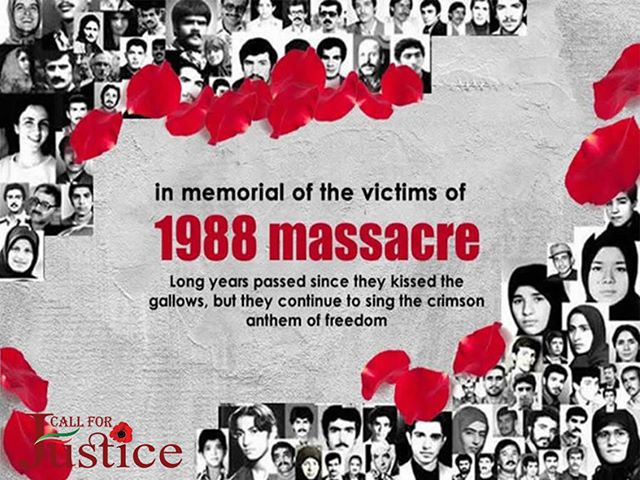
More than 30,000 political prisoners, mainly MEK activists were slain during the summer of 1988, a crime against humanity that has yet to be accounted for.
Patrick Goodenough published an opinion piece on CNS news on Friday, December 7th. The piece, entitled, “New Report: UN Should Investigate Secret Execution of Thousands of Iranian Dissidents 30 Years Ago”, referred to Amnesty International’s latest report on the 1988 massacre.
Amnesty International collected witness testimonies, audio and video evidence, as well as extensive documentation on the extra-judicial killings that took place in the summer of 1988. The report found that the Iranian regime systematically rounded up and killed members of the Iranian opposition, including members of the People’s Mujahedin Organisation of Iran (MEK).
Crime against Humanity: Girls as young as 13 and 15 and pregnant #women were among those massacred.#1988Massacre https://t.co/4aR72MSXF7
— Women's Committee NCRI (@womenncri) December 8, 2018
Around 30,000 dissidents were executed during the summer of 1988. The regime dumped their bodies in mass graves. The mullahs then worked tirelessly destroy evidence of their atrocities. To this day, they have refused to come clean about the events that took place that summer and refused to reveal the locations of the mass graves.
Ongoing Crimes Against Humanity
Patrick Goodenough quoted Amnesty International’s Middle East and Africa research and advocacy director, Philip Luther, who said, “until Iran’s authorities come clean and publicly reveal the fate and whereabouts of the victims, these crimes against humanity are ongoing”.
Thorough new @Amnesty report on the mass murder of Iranian detainees between July & Sept 1988. The victims thought they were in court for a pardon, realising they were to be hanged only minutes before death. They are buried in unmarked mass graves. https://t.co/XtT14kNa1v
— Louisa Loveluck (@leloveluck) December 5, 2018
Amnesty International is calling for a UN investigation into the forced disappearances and killings.
The report, Goodenough says, suggests that there may have been 32 execution locations used in the killings, spread out across Iran. Prisons during the period were placed on “lockdown” and family visits were suspended, leaving many victim’s families unsure whether their loved one was dead or alive.
Many of Those Responsible Hold Positions of Authority Today
Goodenough laments that many of the regime’s “death commissions” responsible for the abduction and execution of political dissidents in 1988 still hold positions in the regime’s political leadership.
Key figures in Iran's #1988Massacre:
Mostafa Pour Mohammadi, justice minister (2013-2017), represented the Intelligence Ministry in the Tehran “death commission”. In 2016 he boasted about his role “We are proud to have carried out God’s commandment concerning the [PMOI]”@amnesty pic.twitter.com/2LuHEkEFhV— Justice for the Victims of 1988 Massacre in Iran (@jvmifoundation) December 5, 2018
The Justice Minister, Alireza Avaei, has strong links to the 1988 atrocities. As does, the former Justice Minister, Mostafa Pourmohammadi, Hossein-Ali Nayyeri, the head of a supreme disciplinary court for judges, and Ebrahim Raeesi, Iran’s former prosecutor general.
Key figures involved in the #1988Massacre:
Alireza Avaei, Iran’s current minister of justice, was the prosecutor general of Dezful in Khuzestan province & was tasked with participating in the “death commission” in that city@amnesty @JavaidRehman @mbachelet @antonioguterres pic.twitter.com/LpaX3xeoyP— Justice for the Victims of 1988 Massacre in Iran (@jvmifoundation) December 4, 2018
All three men where present at a “death commission” meeting in 1988, of which secret recordings were leaked to the public in 2016. During the meeting, Grand Ayatollah Hossein Ali Montarezi is clearly heard warning those in attendance that the extra-judicial killings would bring international criticism. He called the crime, “the biggest crime in the history of the Islamic Republic”.
#Iran’s leaders have openly celebrated the mass slaughter of thousands of political dissidents in 1988, grotesquely hailing the killers as heroes.
It’s time for a different story. We demand #TruthAndJusticeNowhttps://t.co/Z3ks14QhfC pic.twitter.com/xtrmMOaCuR
— Kumi Naidoo (@kuminaidoo) December 4, 2018
Montazeri’s defiance of the regime and criticism of its crimes led to his house arrest before he died in 2009.
Goodenough’s report acknowledged that it will take significant public pressure to bring about the opening of a UN investigation into the matter. He quoted Safavi of the National Council of Resistance of Iran (NCRI), who said that it would take “a major public pressure campaign, perhaps a strong push at the UN by the United States to call on the UN secretary general to initiate an independent inquiry into the massacre”.
Staff Writer
